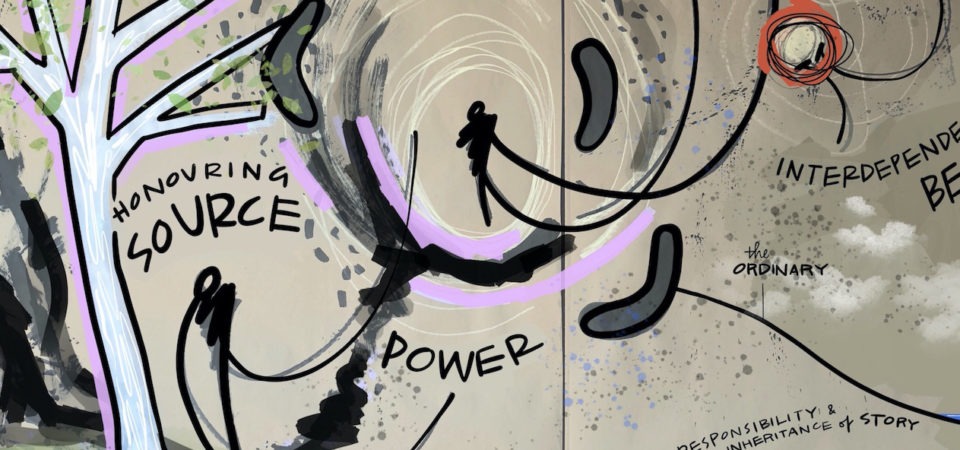Mixed media scribing from the online Burren Leadership Gatherings (detail).
Paper, ink, acrylic, and digital painting. August, 2020.
This article is published on the MAHB Blog and the MAHB Arts Community page.
“All crises operate in connection to each other.”
– Syafiatudina
As an artist, what is my job?
I am a scribe, and my job includes drawing, making marks, writing down the right words at the right time, in the right sequence and in right relationship to each other. It also goes beyond these core acts.

Live digital scribing image created during Moral Imaginations sessions with the Onion Collective and the community of Watchet, hosted by Phoebe Tickell & team. February, 2021.
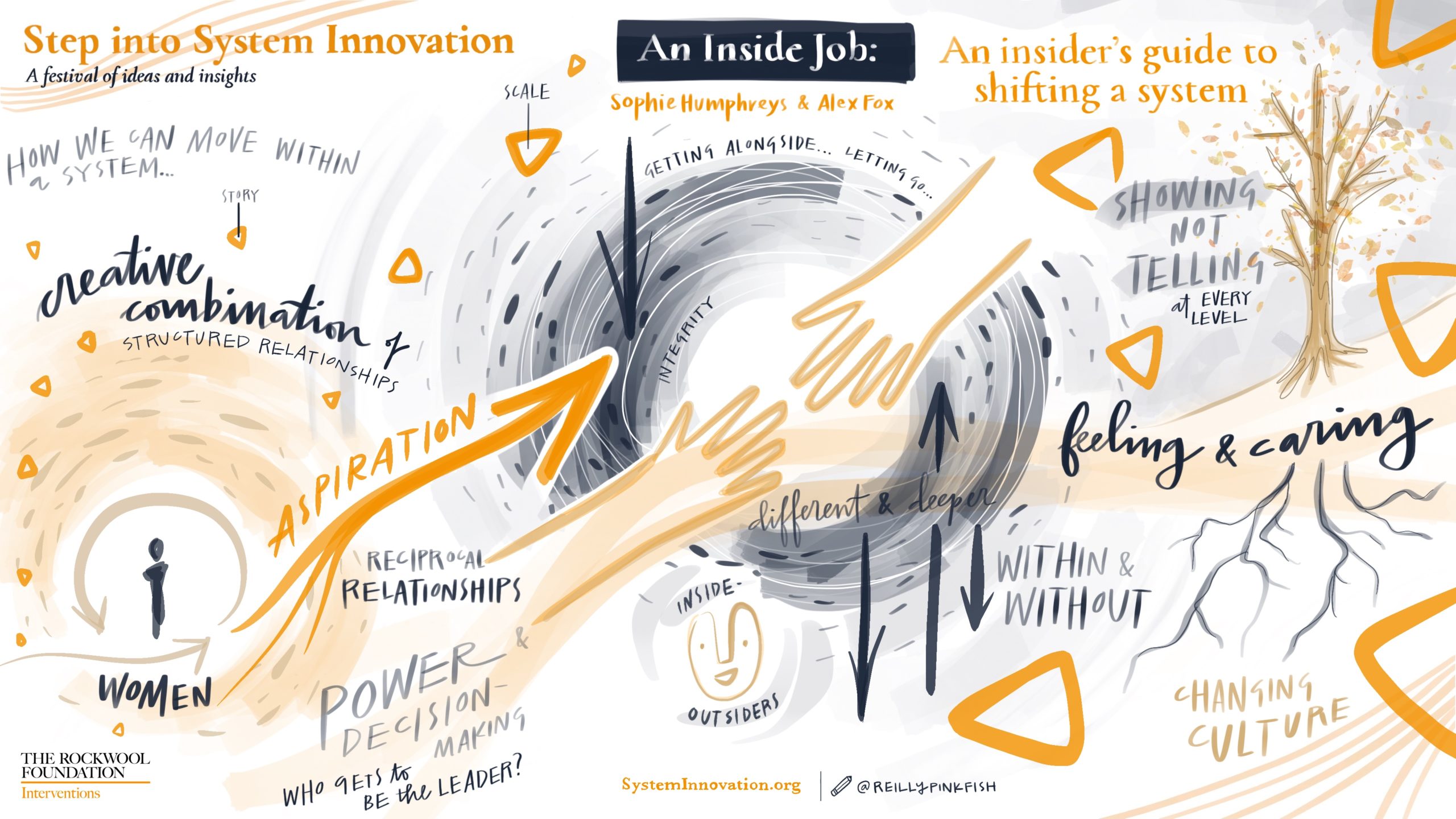
Live digital scribing image created during the conference Step Into System Innovation.
November, 2020.
I’ve been wondering what the essential roles are for artists now, especially as many of us find ourselves in “an increased condition of gathering on-line” (Rocha & Gürses, 2021). Role is not the right word – identity might be better. Then again, maybe it is important to consider the contributions of artists as work. Work that is impossible to separate from identity and ways of being. Work that inherently involves thinking and feeling. And there is a lot to be thought and felt just now, in all of our acute fragilities, shared and private; in our grief and confusion.
So many different forms of caring and noticing are work.
What are the qualities we can bring as artists to the spaces we inhabit now? Whether those are physical, virtual, social, imagined, professional, family spaces. Synchronous, asynchronous, local, distributed, mediated by technology, or not. Whether we are writing, making images, dancing or engaging in other practices with the body, acting, creating music, sculpting, archiving, curating, coding. You could argue it is inadvisable to do almost anything without artists, at this point. (Important to note that artists are not always good people who act in ethical ways. Like anyone else, we can cause harm, and we are complicit in dangerous, unsustainable systems.)
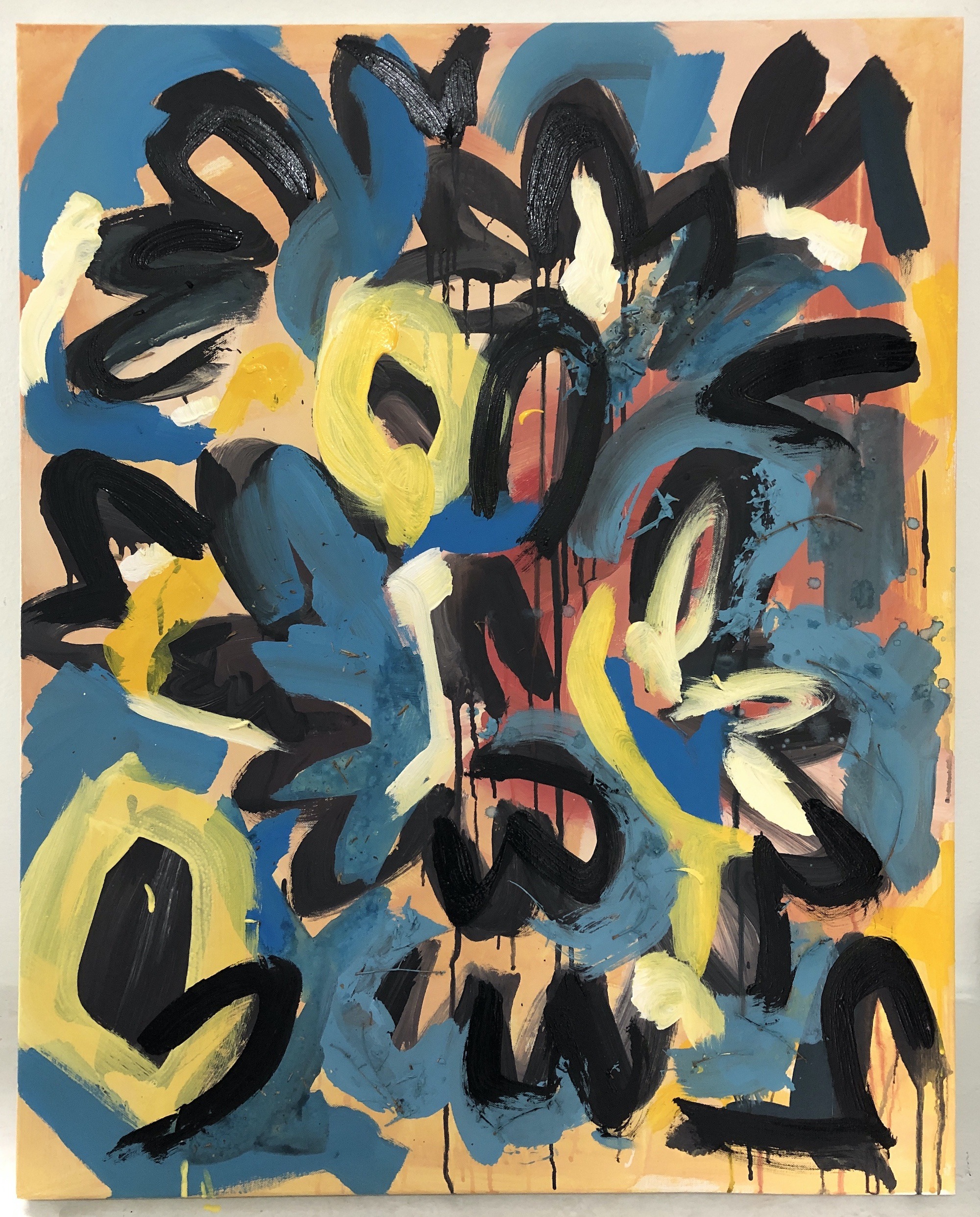
World on fire
January 2020
Acrylic and twigs on canvas
In January of 2020, I started a painting called world on fire. Recently, I heard someone say we also need to pay attention to those parts of the world that are not on fire.
On March 13, 2021, as I am writing this, one year exactly has gone by since I started sheltering. I was already used to working from home and equipped to do so. But before the pandemic, I had a second mode – moving alone in taxis and planes, before immersing myself in a group of people and a place; traveling to different areas of Mexico City, where I live, and other parts of the world, to do my work. Carrying boards, paper, markers, ink, and tape.
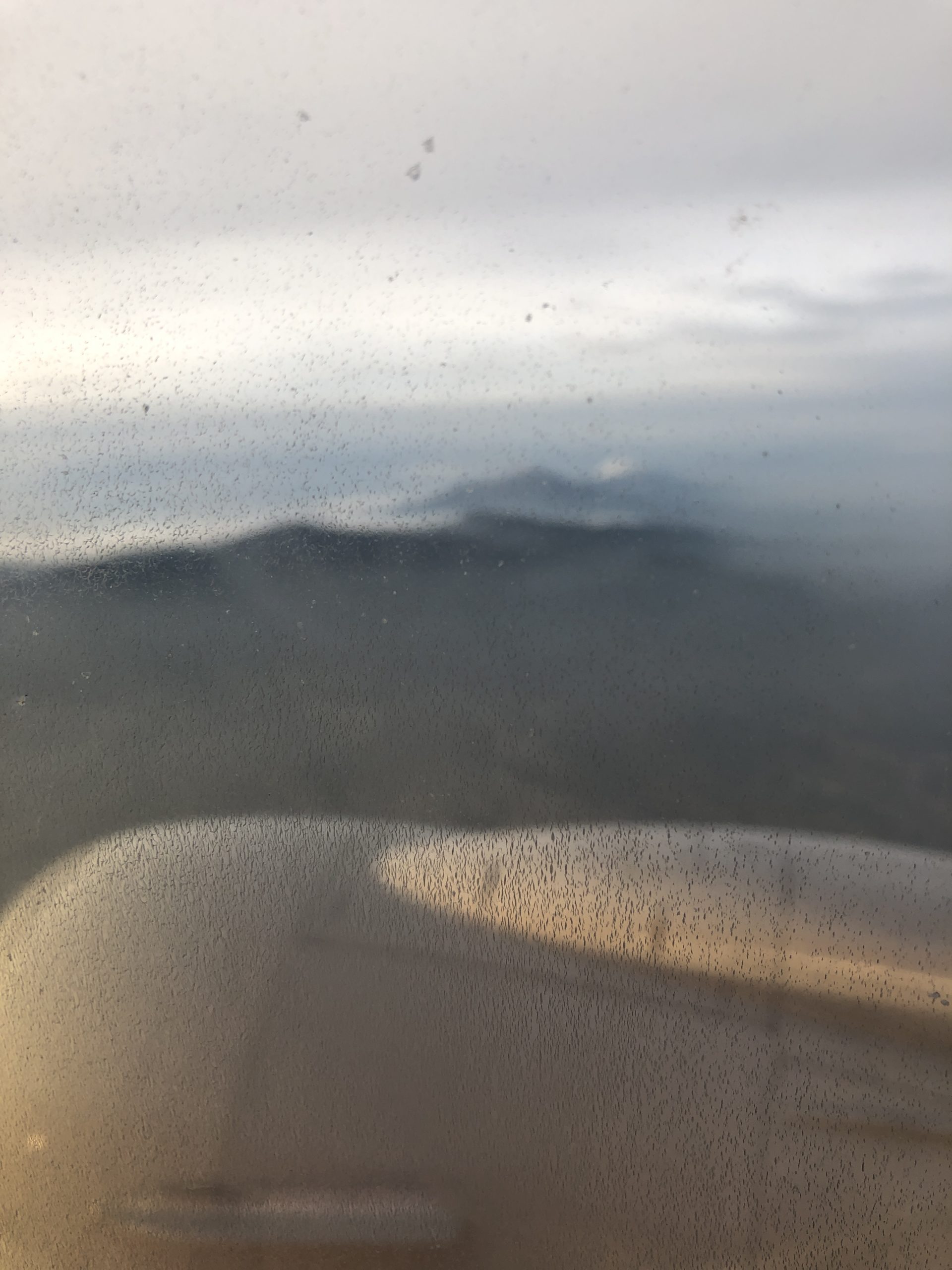
Untitled photo, taking off from Mexico City
June, 2018 (the “before” times)
I think switching between modes allowed me to ignore certain things, as I spent part of my time moving from place to place, and back again. When I stopped travelling and traced movements between rooms not airports, a few things started to take shape in my mind: my own physical needs, cycles, and relationship with time. What seemed almost random in the context of my pre-pandemic schedule now had a clearer rhythm, and I realized I needed to take care of myself and my relationships in ways I perhaps had not been. Calling my family more often, more deliberately. Listening carefully to what was said and not said, what might be woven into the tone of each conversation.
Over the last year I have rotated the position of my desk over and over, trying to find the right backdrop, trying to make sure my partner can move freely while I connect to video calls from our apartment. We live in an old building that sits on a perceptible incline – if you place a ball on the floor, it will roll – and I never seem to find the perfect angle, the way to place myself, to avoid wear and tear in my joints from off-kilter sitting.
The conspicuous presence of birds and insects in the city made their usual absence feel wrong. There has been a lot of new noticing to be undertaken.
The past year has been an inward time for me in many ways, which I enjoy. As adrienne maree brown writes, “if you’re good, say you’re good. it doesn’t negate reality, it weaves your reality into the fabric of this complex time.” At the same time, there seems to be an intense hunger, a frenzy of online meetings, events, workshops, gatherings, conversations, webinars. I am so grateful to feel connected to people in faraway places and have the chance to be part of many different kinds of conversations and interactions. And, I have found it challenging to keep up at times. I know I need to look after my energy. To tend the spaces inside myself so I can keep showing up, when and where invited. Sometimes caring people in my life will suggest I “take less on.” I hear their advice but usually do not follow it. This is a time of too much and too little. Our illusions of separateness and independence have been melting. Should I set clearer boundaries? Should I interrogate the ones I already had? Shouldn’t I be doing more? Or was it less? Either way, new relationships are forming. Learning is happening. Loss is happening. Change is happening.
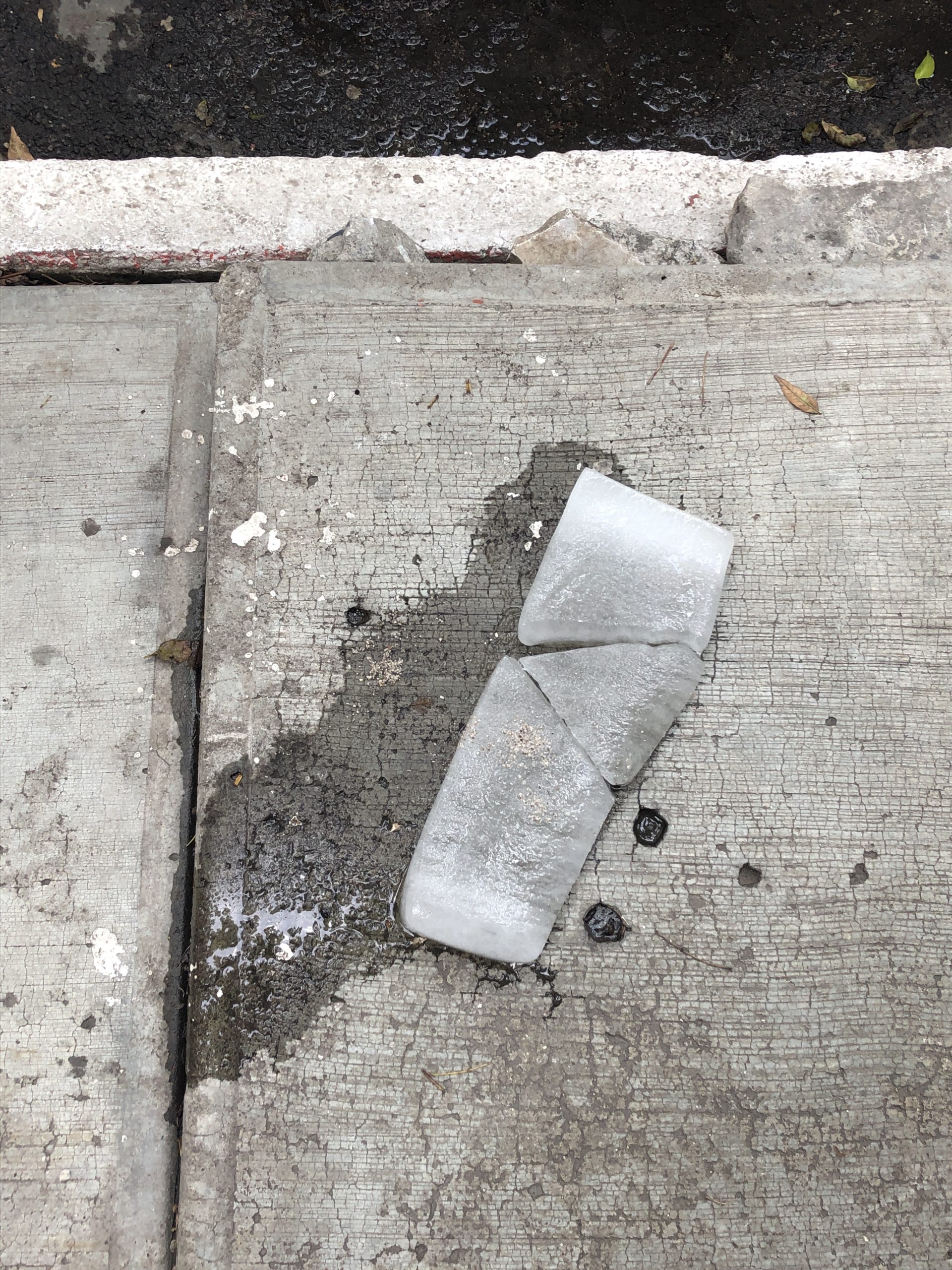
Untitled photo from the ongoing project Sidewalks of Mexico City
What kinds of encounters are possible now? As artists, how can we help navigate the heartbreak of remembering that we are not separate from nature? (There are of course many who never lost sight of this.)

Mixed media scribing from the online Burren Leadership Gatherings
Paper, ink, acrylic, and digital painting. August, 2020
Art is one way of acknowledging and creating spaces inside myself where all are welcome, something like Milarepa’s demons. What parts of ourselves individually and collectively have not been welcomed in, and taken on a sharp, resentful, even violent quality as a result? Like the terrifying other version of the family, in Jordan Peele’s film Us, who appear uninvited in the night. The underbelly, the hidden shadow. They seem to be spilling out all around us, in politics, in language, in the news. And yet, even the most vile of these voices seem to get metabolized somehow and commodified by our systems and culture. Is this a window of opportunity to aerate some of these aspects of ourselves and the world?
Has every moment ever been a window of opportunity of one kind of another, simply requiring slower and more careful seeing? The stakes feel higher now but now is of course the only time I have experienced.
What if we were to realize, as curator Syafiatudina writes, “we are living together in precarity”?
I hope we can avoid defining the roles for artists too narrowly. We are here for so much more than decorating and documenting the current system, the way things are. Panthea Lee writes on Twitter, “to create joyous futures, we need different powers: Our artists & writers (with radical imagination) to see beyond our current realities. Our activists (with moral clarity) to set the bar for solutions. Our community groups (with loving generosity) to model radical alternatives.”
I find hope and possibility in this combinatory, alchemical mindset. Imagining embryonic futures, connecting to rich and messy pasts, and being present in the here and now. Can we bring permission-granting, door-opening, idea-generating attitudes? Can we help ward off and subvert the “cultural and aesthetic flattening” (Rocha & Gürses, 2021) taking place? Can we invite other parts of ourselves to the dinner table? Can we be warm and welcoming towards them?
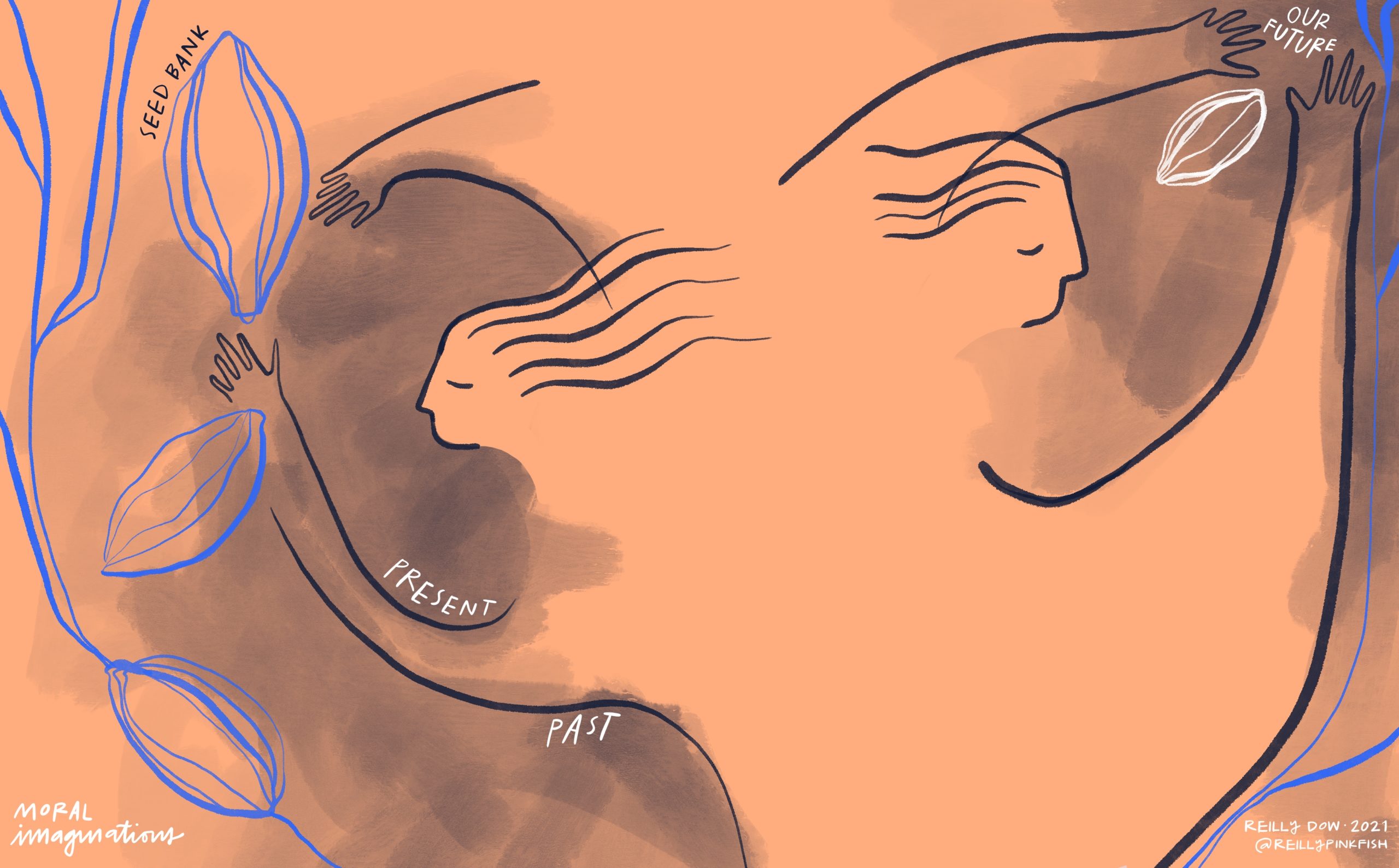
Live digital scribing image created during Moral Imaginations sessions with the Onion Collective and the community of Watchet, hosted by Phoebe Tickell & team. February, 2021.
The details of our days and lives matter. It seems like we have collectively come to recognize the home as a site of work, which, as anyone who works in homes or at home knows, it was all along. Several spheres of our being and doing have collided. But, as Rebecca Solnit writes, “the ways creative work gets done are always unpredictable, demanding room to roam, refusing schedules and systems. They cannot be reduced to replicable formulas.” Even as I have adjusted to working from home, I feel increasingly protective.
In an interview with fellow writer Doreen St. Felix, Jia Tolentino says, “who we are as people is really precious, and the things we do to figure ourselves out are precious and important. They weren’t meant to be the economic foundation of the internet. The things we search on Google are questions, they were not meant to have ads sold against them. There’s something about real personhood that feels like it buckles under all that economic weight.” Even in this supposedly simpler version of a life, pandemic life, I need spaces of silence, spaces between. As Virginia Woolf writes (as cited by Solnit, 2014), “to think; well, not even to think. To be silent; to be alone. All the being and the doing, expansive, glittering, vocal, evaporated.” There is no final solution to the tension between self and other, self and community; care of the self and offering what we can, when we can. The boundary place between what I need and what you need. What the world needs. What we didn’t know we needed.
In the spirit of sharing practices that may be helpful to others, during the pandemic, I have felt sustained by:
- Cooking
- Therapy
- Painting
- Listening to poets read their poetry
- Doing demanding “brain work” in the mornings and switching to tidying up and working with the physical world in the afternoons
- Dancing in the kitchen
- Sitting on the rooftop of our apartment building, maybe with a few friends when we can
- Taking my dog for walks
- Pulling a book off the shelf, and maybe another
- Reading
- Looking at other artists’ noticings on Instagram
- Well-crafted memes
- Calling a friend
- Calling an auntie
- Writing down dreams
- Putting on music
- Breathing
- And, forgiving myself when I feel like I should do these things, or other things, and I don’t.
Some days I will do more, some days I will do less. If there is a window of opportunity now, I believe artists may be uniquely qualified to bring clarity and at the same time recognize and surface ambiguities; to tell the truth as best we can; to take one step forward, two steps back, a half-step to the side, then sit and draw a circle around us all. I have come home to myself over the last year even while missing friends and family to the point of heartbreak. Where to from here remains an open question, and the asking of it is a beautiful thing.
References
Brown, a. m. (2021). “if you’re good, say you’re good.”
Lee, P. (December 31, 2020).
https://twitter.com/PantheaLee/status/1344714163810136065
Rocha, J., & Gürses, S. (2021). “A catalog of formats for digital discomfort… and other ways to resist totalitarian zoomification.”
Solnit, R. (2014). “Woolf’s darkness: Embracing the inexplicable”
St. Felix, D., & Tolentino, J. (2019).
https://www.youtube.com/watch?v=JBdDfjMMXNs
Syafiatudina. (February 8, 2021). “What’s left to learn from ruins?”\
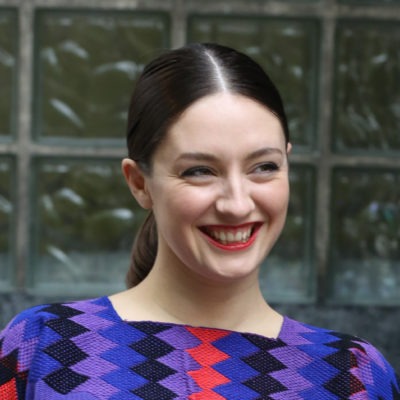 Reilly is a listener, visual artist and scribe based in Mexico City, situated in the traditional territory of the Mexica, Otomí and Mazahuas. She grew up on Georgian Bay in Ontario, Canada, spending a lot of time in the woods before moving to Mexico at the age of 18.
Reilly is a listener, visual artist and scribe based in Mexico City, situated in the traditional territory of the Mexica, Otomí and Mazahuas. She grew up on Georgian Bay in Ontario, Canada, spending a lot of time in the woods before moving to Mexico at the age of 18.
Since 2008, she has supported groups and organizations on four continents, creating visual artifacts in the room or during virtual gatherings to add texture and colour, and invite creativity, depth, and relationship. She is fascinated by the unplanned, improvisational and unfolding aspects of group dialogue and collective learning.
Reilly has been a member of the facilitation team for the Burren Leadership Retreat since 2016, and she is part of the global delivery network for Visual Practice Workshop, led by Kelvy Bird and Alfredo Carlo. She is a certified Warm Data Lab Host, a member of the International Forum of Visual Practitioners (IFVP), and holds a Masters degree in Interdisciplinary Studies.
She lives in Colonia Roma with her boyfriend and their dog. You can find more of her work at Pinkfish.ca, and on Twitter and Instagram.
The MAHB Blog is a venture of the Millennium Alliance for Humanity and the Biosphere. Questions should be directed to joan@mahbonline.org
This article is part of the MAHB Arts Community‘s “Covid19 Diaries Series”. If you are an artist interested in sharing your thoughts and artwork, as it relates to the disrupted but defining period of time we live in, please contact Michele Guieu, Eco-Artist, MAHB Member, and MAHB Arts Community coordinator: michele@mahbonline.org.
Thank you. ~

